HRM Final Review: HR Functions, Practices, and Strategic Alignment
VerifiedAdded on 2022/08/13
|10
|2609
|49
Report
AI Summary
This report provides a comprehensive review of Human Resource Management (HRM) functions and practices. It begins by defining HRM and its critical role in aligning human capital with organizational strategy to drive growth. The report then delves into key HRM elements, including staffing, which covers recruitment methods (direct, indirect, third-party, and internal sources), and the importance of aligning recruitment with organizational goals. Training is discussed, emphasizing the need for skilled employees and the analysis of training requirements, incorporating adult learning theories, and the use of SMART goals. Performance management and evaluation are explored, highlighting the importance of aligning HRM with strategic planning, output-based assessments, and employee well-being. The report also covers compensation philosophies, examining factors influencing compensation, compensation policies, and the Herzberg's two-factor theory. Overall, the report emphasizes the strategic importance of HRM in attracting, retaining, and developing employees to achieve organizational success.
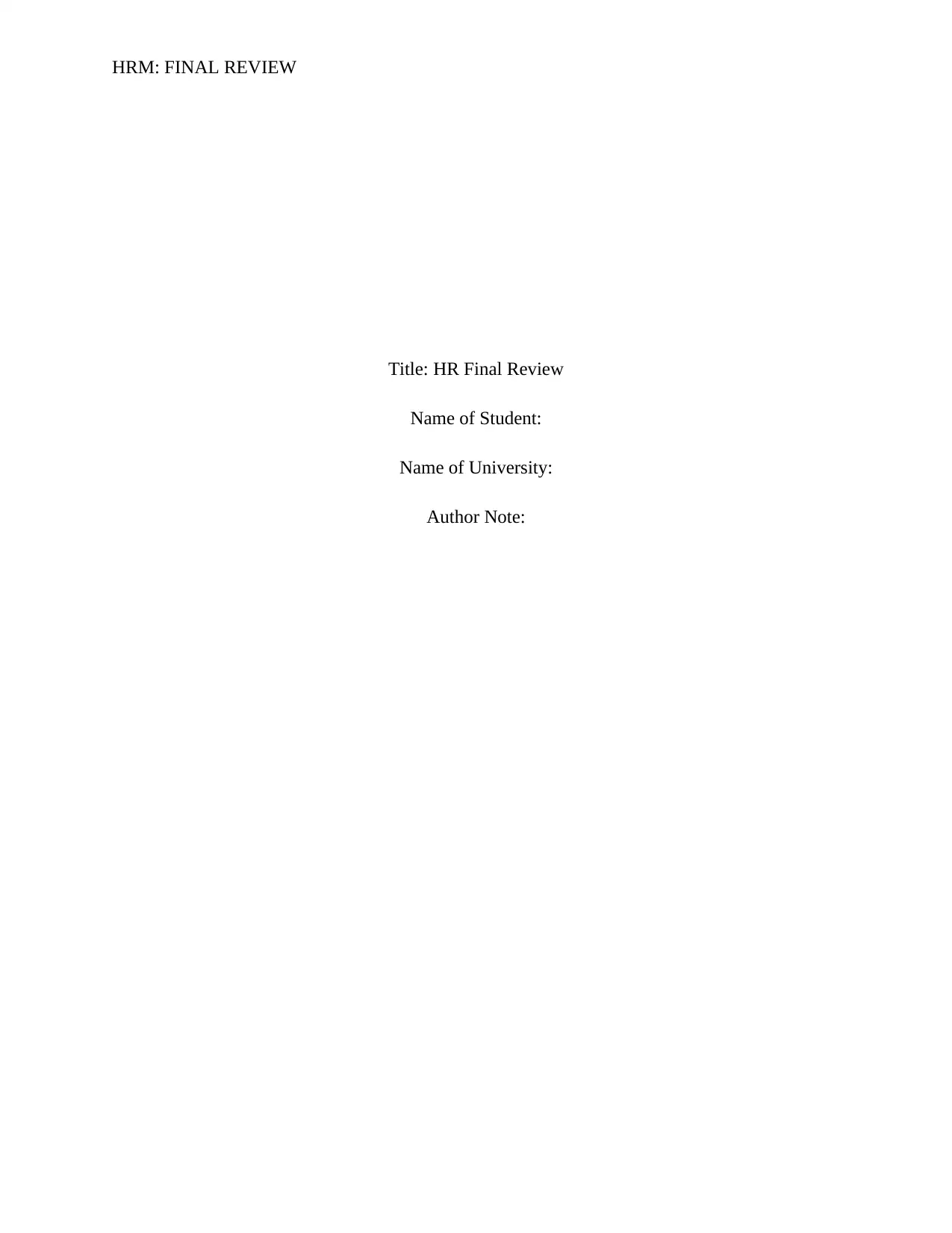
HRM: FINAL REVIEW
Title: HR Final Review
Name of Student:
Name of University:
Author Note:
Title: HR Final Review
Name of Student:
Name of University:
Author Note:
Paraphrase This Document
Need a fresh take? Get an instant paraphrase of this document with our AI Paraphraser
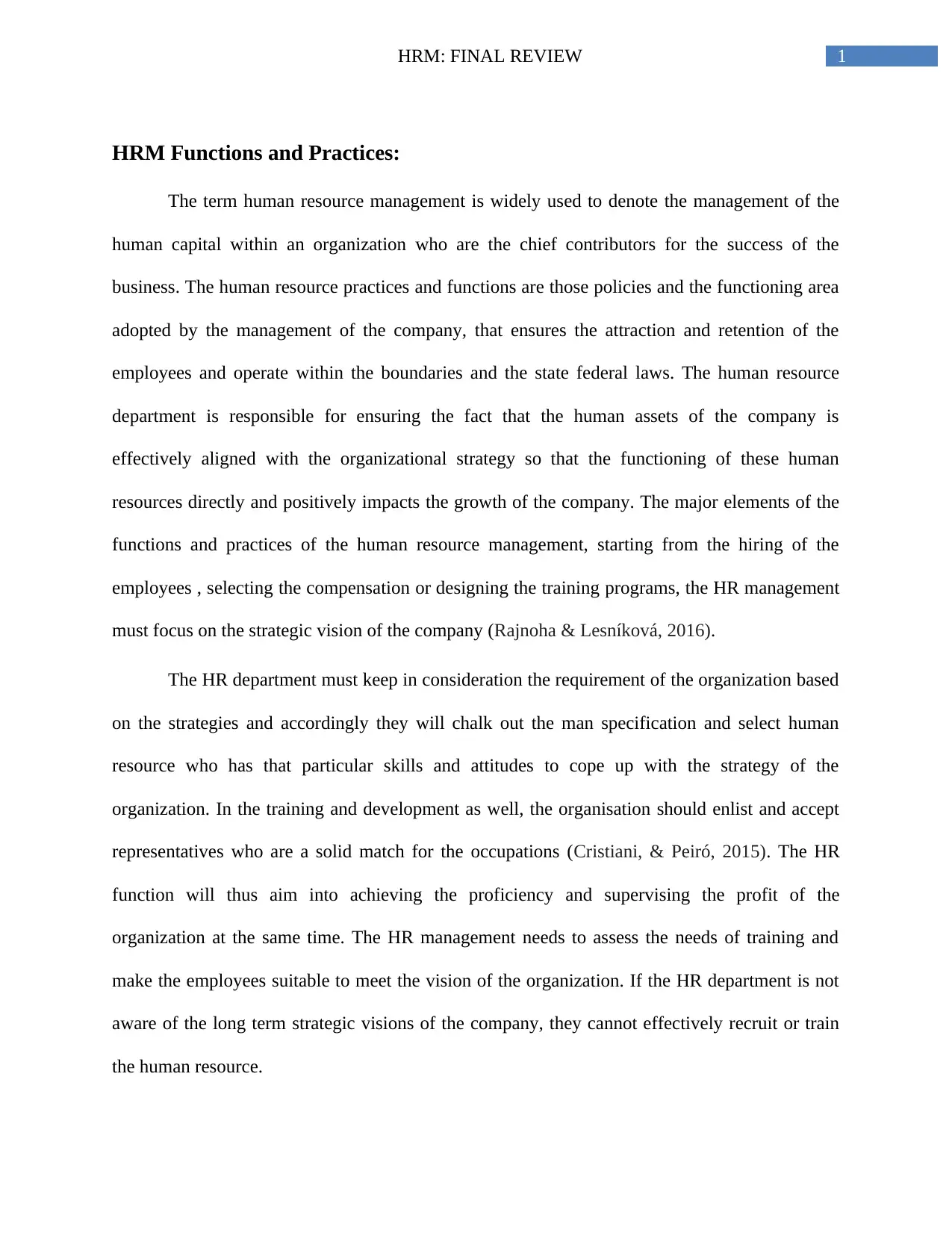
1HRM: FINAL REVIEW
HRM Functions and Practices:
The term human resource management is widely used to denote the management of the
human capital within an organization who are the chief contributors for the success of the
business. The human resource practices and functions are those policies and the functioning area
adopted by the management of the company, that ensures the attraction and retention of the
employees and operate within the boundaries and the state federal laws. The human resource
department is responsible for ensuring the fact that the human assets of the company is
effectively aligned with the organizational strategy so that the functioning of these human
resources directly and positively impacts the growth of the company. The major elements of the
functions and practices of the human resource management, starting from the hiring of the
employees , selecting the compensation or designing the training programs, the HR management
must focus on the strategic vision of the company (Rajnoha & Lesníková, 2016).
The HR department must keep in consideration the requirement of the organization based
on the strategies and accordingly they will chalk out the man specification and select human
resource who has that particular skills and attitudes to cope up with the strategy of the
organization. In the training and development as well, the organisation should enlist and accept
representatives who are a solid match for the occupations (Cristiani, & Peiró, 2015). The HR
function will thus aim into achieving the proficiency and supervising the profit of the
organization at the same time. The HR management needs to assess the needs of training and
make the employees suitable to meet the vision of the organization. If the HR department is not
aware of the long term strategic visions of the company, they cannot effectively recruit or train
the human resource.
HRM Functions and Practices:
The term human resource management is widely used to denote the management of the
human capital within an organization who are the chief contributors for the success of the
business. The human resource practices and functions are those policies and the functioning area
adopted by the management of the company, that ensures the attraction and retention of the
employees and operate within the boundaries and the state federal laws. The human resource
department is responsible for ensuring the fact that the human assets of the company is
effectively aligned with the organizational strategy so that the functioning of these human
resources directly and positively impacts the growth of the company. The major elements of the
functions and practices of the human resource management, starting from the hiring of the
employees , selecting the compensation or designing the training programs, the HR management
must focus on the strategic vision of the company (Rajnoha & Lesníková, 2016).
The HR department must keep in consideration the requirement of the organization based
on the strategies and accordingly they will chalk out the man specification and select human
resource who has that particular skills and attitudes to cope up with the strategy of the
organization. In the training and development as well, the organisation should enlist and accept
representatives who are a solid match for the occupations (Cristiani, & Peiró, 2015). The HR
function will thus aim into achieving the proficiency and supervising the profit of the
organization at the same time. The HR management needs to assess the needs of training and
make the employees suitable to meet the vision of the organization. If the HR department is not
aware of the long term strategic visions of the company, they cannot effectively recruit or train
the human resource.
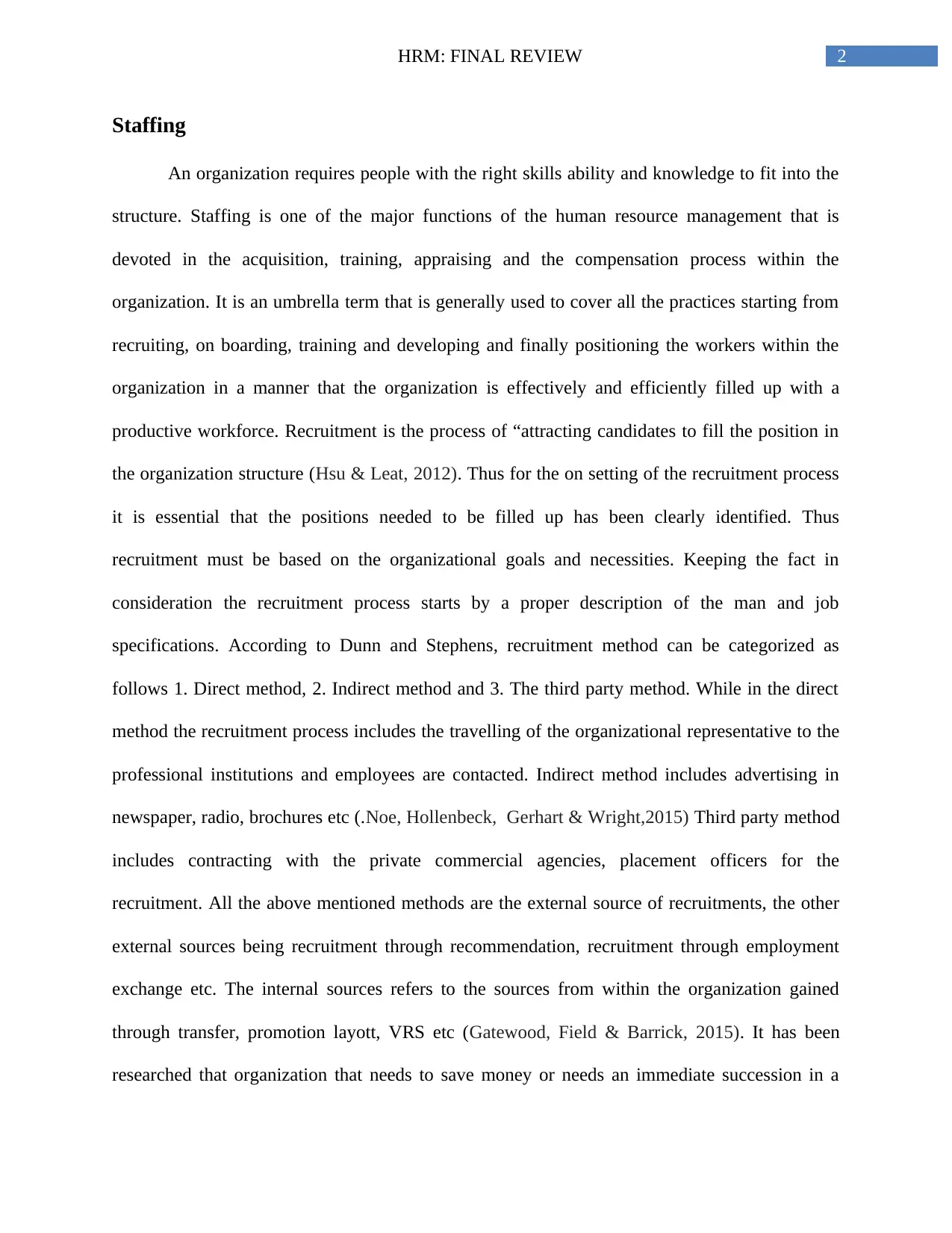
2HRM: FINAL REVIEW
Staffing
An organization requires people with the right skills ability and knowledge to fit into the
structure. Staffing is one of the major functions of the human resource management that is
devoted in the acquisition, training, appraising and the compensation process within the
organization. It is an umbrella term that is generally used to cover all the practices starting from
recruiting, on boarding, training and developing and finally positioning the workers within the
organization in a manner that the organization is effectively and efficiently filled up with a
productive workforce. Recruitment is the process of “attracting candidates to fill the position in
the organization structure (Hsu & Leat, 2012). Thus for the on setting of the recruitment process
it is essential that the positions needed to be filled up has been clearly identified. Thus
recruitment must be based on the organizational goals and necessities. Keeping the fact in
consideration the recruitment process starts by a proper description of the man and job
specifications. According to Dunn and Stephens, recruitment method can be categorized as
follows 1. Direct method, 2. Indirect method and 3. The third party method. While in the direct
method the recruitment process includes the travelling of the organizational representative to the
professional institutions and employees are contacted. Indirect method includes advertising in
newspaper, radio, brochures etc (.Noe, Hollenbeck, Gerhart & Wright,2015) Third party method
includes contracting with the private commercial agencies, placement officers for the
recruitment. All the above mentioned methods are the external source of recruitments, the other
external sources being recruitment through recommendation, recruitment through employment
exchange etc. The internal sources refers to the sources from within the organization gained
through transfer, promotion layott, VRS etc (Gatewood, Field & Barrick, 2015). It has been
researched that organization that needs to save money or needs an immediate succession in a
Staffing
An organization requires people with the right skills ability and knowledge to fit into the
structure. Staffing is one of the major functions of the human resource management that is
devoted in the acquisition, training, appraising and the compensation process within the
organization. It is an umbrella term that is generally used to cover all the practices starting from
recruiting, on boarding, training and developing and finally positioning the workers within the
organization in a manner that the organization is effectively and efficiently filled up with a
productive workforce. Recruitment is the process of “attracting candidates to fill the position in
the organization structure (Hsu & Leat, 2012). Thus for the on setting of the recruitment process
it is essential that the positions needed to be filled up has been clearly identified. Thus
recruitment must be based on the organizational goals and necessities. Keeping the fact in
consideration the recruitment process starts by a proper description of the man and job
specifications. According to Dunn and Stephens, recruitment method can be categorized as
follows 1. Direct method, 2. Indirect method and 3. The third party method. While in the direct
method the recruitment process includes the travelling of the organizational representative to the
professional institutions and employees are contacted. Indirect method includes advertising in
newspaper, radio, brochures etc (.Noe, Hollenbeck, Gerhart & Wright,2015) Third party method
includes contracting with the private commercial agencies, placement officers for the
recruitment. All the above mentioned methods are the external source of recruitments, the other
external sources being recruitment through recommendation, recruitment through employment
exchange etc. The internal sources refers to the sources from within the organization gained
through transfer, promotion layott, VRS etc (Gatewood, Field & Barrick, 2015). It has been
researched that organization that needs to save money or needs an immediate succession in a
⊘ This is a preview!⊘
Do you want full access?
Subscribe today to unlock all pages.

Trusted by 1+ million students worldwide
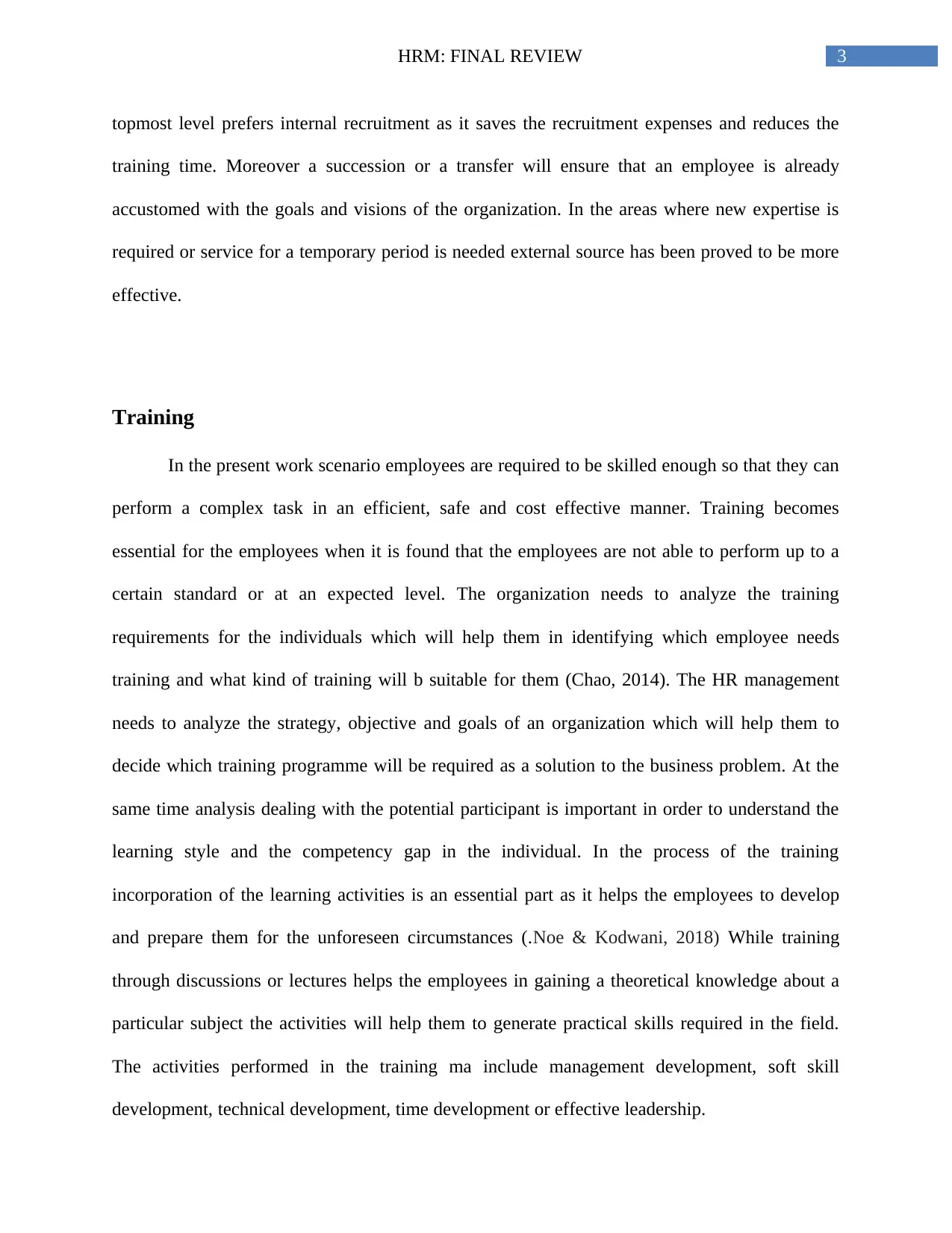
3HRM: FINAL REVIEW
topmost level prefers internal recruitment as it saves the recruitment expenses and reduces the
training time. Moreover a succession or a transfer will ensure that an employee is already
accustomed with the goals and visions of the organization. In the areas where new expertise is
required or service for a temporary period is needed external source has been proved to be more
effective.
Training
In the present work scenario employees are required to be skilled enough so that they can
perform a complex task in an efficient, safe and cost effective manner. Training becomes
essential for the employees when it is found that the employees are not able to perform up to a
certain standard or at an expected level. The organization needs to analyze the training
requirements for the individuals which will help them in identifying which employee needs
training and what kind of training will b suitable for them (Chao, 2014). The HR management
needs to analyze the strategy, objective and goals of an organization which will help them to
decide which training programme will be required as a solution to the business problem. At the
same time analysis dealing with the potential participant is important in order to understand the
learning style and the competency gap in the individual. In the process of the training
incorporation of the learning activities is an essential part as it helps the employees to develop
and prepare them for the unforeseen circumstances (.Noe & Kodwani, 2018) While training
through discussions or lectures helps the employees in gaining a theoretical knowledge about a
particular subject the activities will help them to generate practical skills required in the field.
The activities performed in the training ma include management development, soft skill
development, technical development, time development or effective leadership.
topmost level prefers internal recruitment as it saves the recruitment expenses and reduces the
training time. Moreover a succession or a transfer will ensure that an employee is already
accustomed with the goals and visions of the organization. In the areas where new expertise is
required or service for a temporary period is needed external source has been proved to be more
effective.
Training
In the present work scenario employees are required to be skilled enough so that they can
perform a complex task in an efficient, safe and cost effective manner. Training becomes
essential for the employees when it is found that the employees are not able to perform up to a
certain standard or at an expected level. The organization needs to analyze the training
requirements for the individuals which will help them in identifying which employee needs
training and what kind of training will b suitable for them (Chao, 2014). The HR management
needs to analyze the strategy, objective and goals of an organization which will help them to
decide which training programme will be required as a solution to the business problem. At the
same time analysis dealing with the potential participant is important in order to understand the
learning style and the competency gap in the individual. In the process of the training
incorporation of the learning activities is an essential part as it helps the employees to develop
and prepare them for the unforeseen circumstances (.Noe & Kodwani, 2018) While training
through discussions or lectures helps the employees in gaining a theoretical knowledge about a
particular subject the activities will help them to generate practical skills required in the field.
The activities performed in the training ma include management development, soft skill
development, technical development, time development or effective leadership.
Paraphrase This Document
Need a fresh take? Get an instant paraphrase of this document with our AI Paraphraser
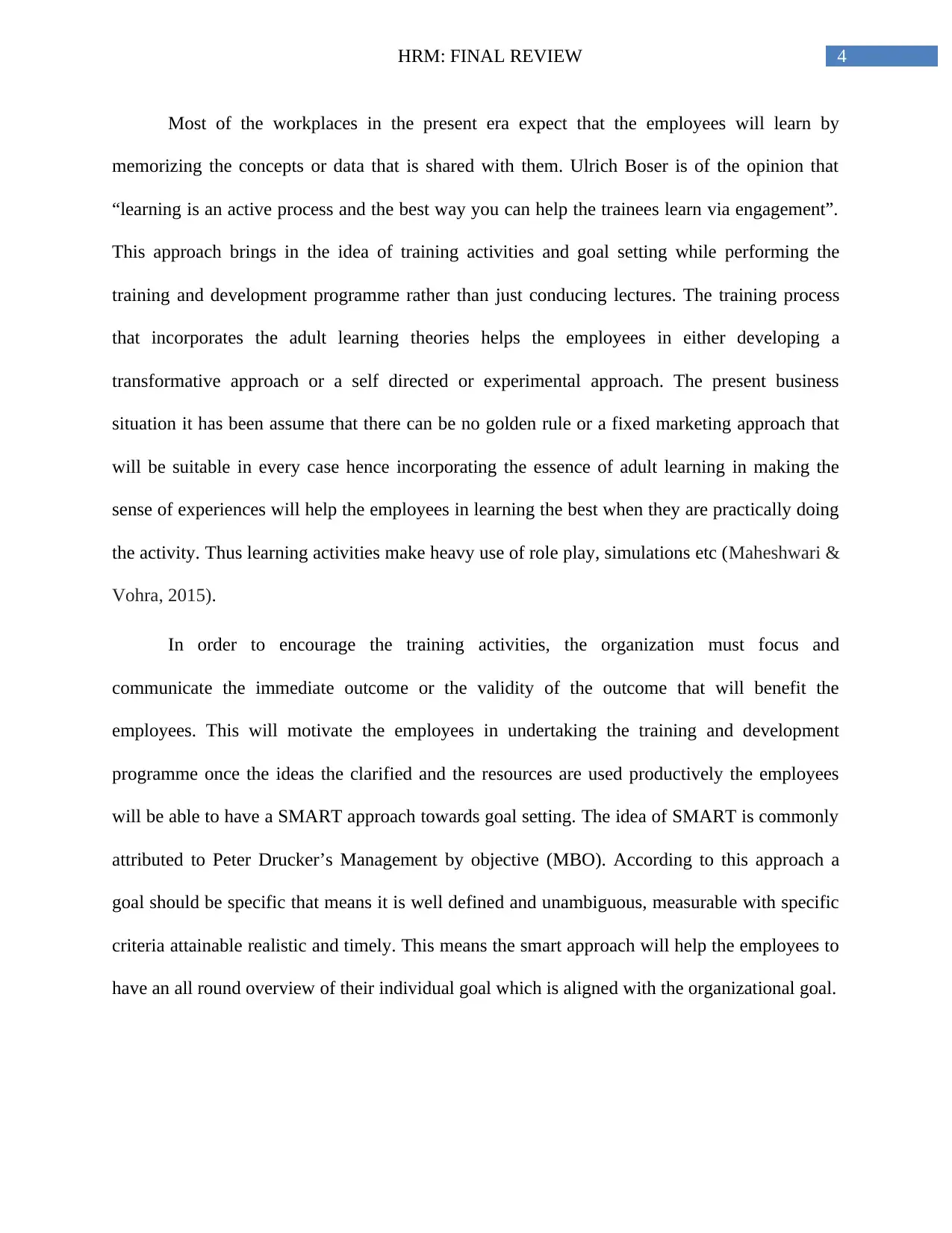
4HRM: FINAL REVIEW
Most of the workplaces in the present era expect that the employees will learn by
memorizing the concepts or data that is shared with them. Ulrich Boser is of the opinion that
“learning is an active process and the best way you can help the trainees learn via engagement”.
This approach brings in the idea of training activities and goal setting while performing the
training and development programme rather than just conducing lectures. The training process
that incorporates the adult learning theories helps the employees in either developing a
transformative approach or a self directed or experimental approach. The present business
situation it has been assume that there can be no golden rule or a fixed marketing approach that
will be suitable in every case hence incorporating the essence of adult learning in making the
sense of experiences will help the employees in learning the best when they are practically doing
the activity. Thus learning activities make heavy use of role play, simulations etc (Maheshwari &
Vohra, 2015).
In order to encourage the training activities, the organization must focus and
communicate the immediate outcome or the validity of the outcome that will benefit the
employees. This will motivate the employees in undertaking the training and development
programme once the ideas the clarified and the resources are used productively the employees
will be able to have a SMART approach towards goal setting. The idea of SMART is commonly
attributed to Peter Drucker’s Management by objective (MBO). According to this approach a
goal should be specific that means it is well defined and unambiguous, measurable with specific
criteria attainable realistic and timely. This means the smart approach will help the employees to
have an all round overview of their individual goal which is aligned with the organizational goal.
Most of the workplaces in the present era expect that the employees will learn by
memorizing the concepts or data that is shared with them. Ulrich Boser is of the opinion that
“learning is an active process and the best way you can help the trainees learn via engagement”.
This approach brings in the idea of training activities and goal setting while performing the
training and development programme rather than just conducing lectures. The training process
that incorporates the adult learning theories helps the employees in either developing a
transformative approach or a self directed or experimental approach. The present business
situation it has been assume that there can be no golden rule or a fixed marketing approach that
will be suitable in every case hence incorporating the essence of adult learning in making the
sense of experiences will help the employees in learning the best when they are practically doing
the activity. Thus learning activities make heavy use of role play, simulations etc (Maheshwari &
Vohra, 2015).
In order to encourage the training activities, the organization must focus and
communicate the immediate outcome or the validity of the outcome that will benefit the
employees. This will motivate the employees in undertaking the training and development
programme once the ideas the clarified and the resources are used productively the employees
will be able to have a SMART approach towards goal setting. The idea of SMART is commonly
attributed to Peter Drucker’s Management by objective (MBO). According to this approach a
goal should be specific that means it is well defined and unambiguous, measurable with specific
criteria attainable realistic and timely. This means the smart approach will help the employees to
have an all round overview of their individual goal which is aligned with the organizational goal.
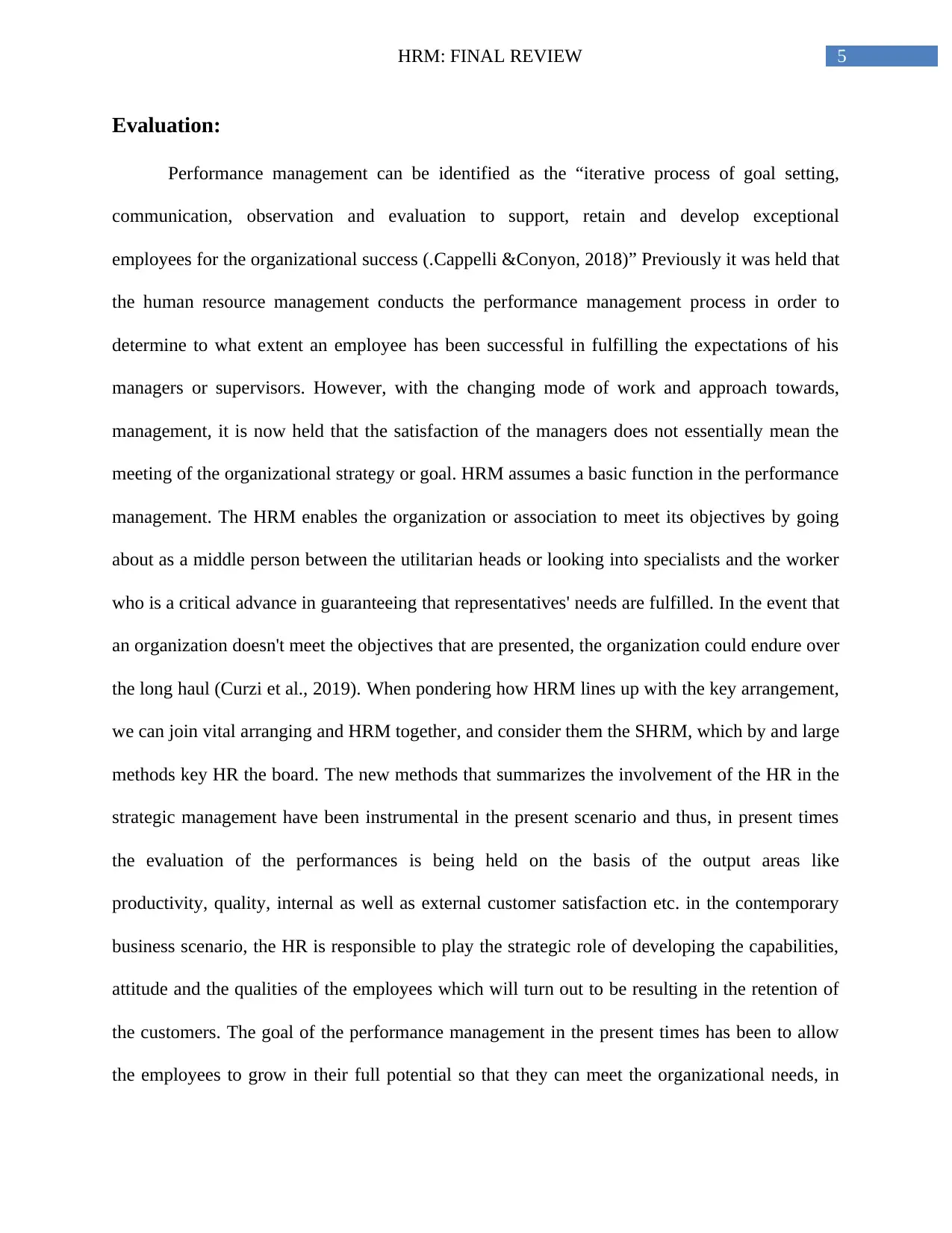
5HRM: FINAL REVIEW
Evaluation:
Performance management can be identified as the “iterative process of goal setting,
communication, observation and evaluation to support, retain and develop exceptional
employees for the organizational success (.Cappelli &Conyon, 2018)” Previously it was held that
the human resource management conducts the performance management process in order to
determine to what extent an employee has been successful in fulfilling the expectations of his
managers or supervisors. However, with the changing mode of work and approach towards,
management, it is now held that the satisfaction of the managers does not essentially mean the
meeting of the organizational strategy or goal. HRM assumes a basic function in the performance
management. The HRM enables the organization or association to meet its objectives by going
about as a middle person between the utilitarian heads or looking into specialists and the worker
who is a critical advance in guaranteeing that representatives' needs are fulfilled. In the event that
an organization doesn't meet the objectives that are presented, the organization could endure over
the long haul (Curzi et al., 2019). When pondering how HRM lines up with the key arrangement,
we can join vital arranging and HRM together, and consider them the SHRM, which by and large
methods key HR the board. The new methods that summarizes the involvement of the HR in the
strategic management have been instrumental in the present scenario and thus, in present times
the evaluation of the performances is being held on the basis of the output areas like
productivity, quality, internal as well as external customer satisfaction etc. in the contemporary
business scenario, the HR is responsible to play the strategic role of developing the capabilities,
attitude and the qualities of the employees which will turn out to be resulting in the retention of
the customers. The goal of the performance management in the present times has been to allow
the employees to grow in their full potential so that they can meet the organizational needs, in
Evaluation:
Performance management can be identified as the “iterative process of goal setting,
communication, observation and evaluation to support, retain and develop exceptional
employees for the organizational success (.Cappelli &Conyon, 2018)” Previously it was held that
the human resource management conducts the performance management process in order to
determine to what extent an employee has been successful in fulfilling the expectations of his
managers or supervisors. However, with the changing mode of work and approach towards,
management, it is now held that the satisfaction of the managers does not essentially mean the
meeting of the organizational strategy or goal. HRM assumes a basic function in the performance
management. The HRM enables the organization or association to meet its objectives by going
about as a middle person between the utilitarian heads or looking into specialists and the worker
who is a critical advance in guaranteeing that representatives' needs are fulfilled. In the event that
an organization doesn't meet the objectives that are presented, the organization could endure over
the long haul (Curzi et al., 2019). When pondering how HRM lines up with the key arrangement,
we can join vital arranging and HRM together, and consider them the SHRM, which by and large
methods key HR the board. The new methods that summarizes the involvement of the HR in the
strategic management have been instrumental in the present scenario and thus, in present times
the evaluation of the performances is being held on the basis of the output areas like
productivity, quality, internal as well as external customer satisfaction etc. in the contemporary
business scenario, the HR is responsible to play the strategic role of developing the capabilities,
attitude and the qualities of the employees which will turn out to be resulting in the retention of
the customers. The goal of the performance management in the present times has been to allow
the employees to grow in their full potential so that they can meet the organizational needs, in
⊘ This is a preview!⊘
Do you want full access?
Subscribe today to unlock all pages.

Trusted by 1+ million students worldwide
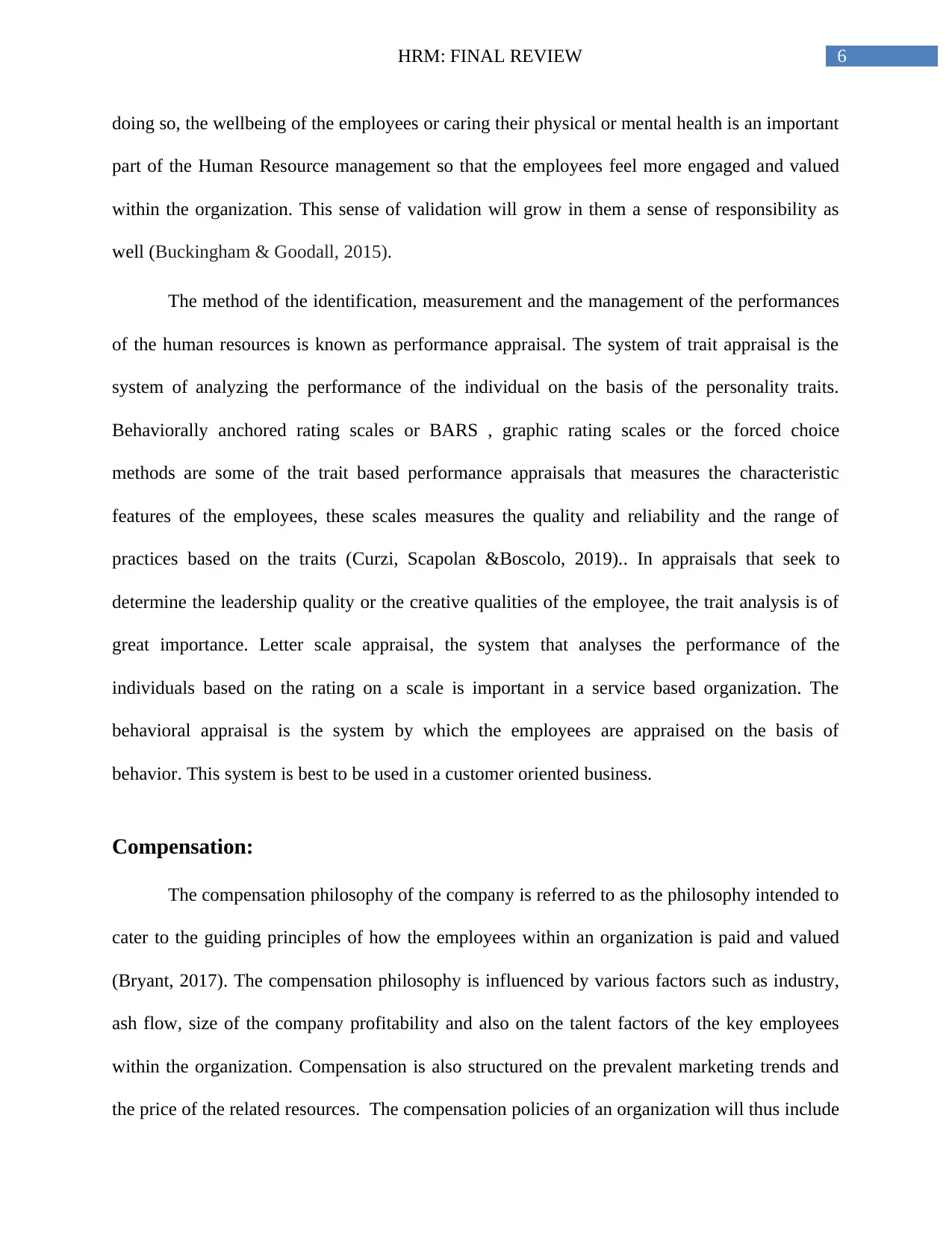
6HRM: FINAL REVIEW
doing so, the wellbeing of the employees or caring their physical or mental health is an important
part of the Human Resource management so that the employees feel more engaged and valued
within the organization. This sense of validation will grow in them a sense of responsibility as
well (Buckingham & Goodall, 2015).
The method of the identification, measurement and the management of the performances
of the human resources is known as performance appraisal. The system of trait appraisal is the
system of analyzing the performance of the individual on the basis of the personality traits.
Behaviorally anchored rating scales or BARS , graphic rating scales or the forced choice
methods are some of the trait based performance appraisals that measures the characteristic
features of the employees, these scales measures the quality and reliability and the range of
practices based on the traits (Curzi, Scapolan &Boscolo, 2019).. In appraisals that seek to
determine the leadership quality or the creative qualities of the employee, the trait analysis is of
great importance. Letter scale appraisal, the system that analyses the performance of the
individuals based on the rating on a scale is important in a service based organization. The
behavioral appraisal is the system by which the employees are appraised on the basis of
behavior. This system is best to be used in a customer oriented business.
Compensation:
The compensation philosophy of the company is referred to as the philosophy intended to
cater to the guiding principles of how the employees within an organization is paid and valued
(Bryant, 2017). The compensation philosophy is influenced by various factors such as industry,
ash flow, size of the company profitability and also on the talent factors of the key employees
within the organization. Compensation is also structured on the prevalent marketing trends and
the price of the related resources. The compensation policies of an organization will thus include
doing so, the wellbeing of the employees or caring their physical or mental health is an important
part of the Human Resource management so that the employees feel more engaged and valued
within the organization. This sense of validation will grow in them a sense of responsibility as
well (Buckingham & Goodall, 2015).
The method of the identification, measurement and the management of the performances
of the human resources is known as performance appraisal. The system of trait appraisal is the
system of analyzing the performance of the individual on the basis of the personality traits.
Behaviorally anchored rating scales or BARS , graphic rating scales or the forced choice
methods are some of the trait based performance appraisals that measures the characteristic
features of the employees, these scales measures the quality and reliability and the range of
practices based on the traits (Curzi, Scapolan &Boscolo, 2019).. In appraisals that seek to
determine the leadership quality or the creative qualities of the employee, the trait analysis is of
great importance. Letter scale appraisal, the system that analyses the performance of the
individuals based on the rating on a scale is important in a service based organization. The
behavioral appraisal is the system by which the employees are appraised on the basis of
behavior. This system is best to be used in a customer oriented business.
Compensation:
The compensation philosophy of the company is referred to as the philosophy intended to
cater to the guiding principles of how the employees within an organization is paid and valued
(Bryant, 2017). The compensation philosophy is influenced by various factors such as industry,
ash flow, size of the company profitability and also on the talent factors of the key employees
within the organization. Compensation is also structured on the prevalent marketing trends and
the price of the related resources. The compensation policies of an organization will thus include
Paraphrase This Document
Need a fresh take? Get an instant paraphrase of this document with our AI Paraphraser
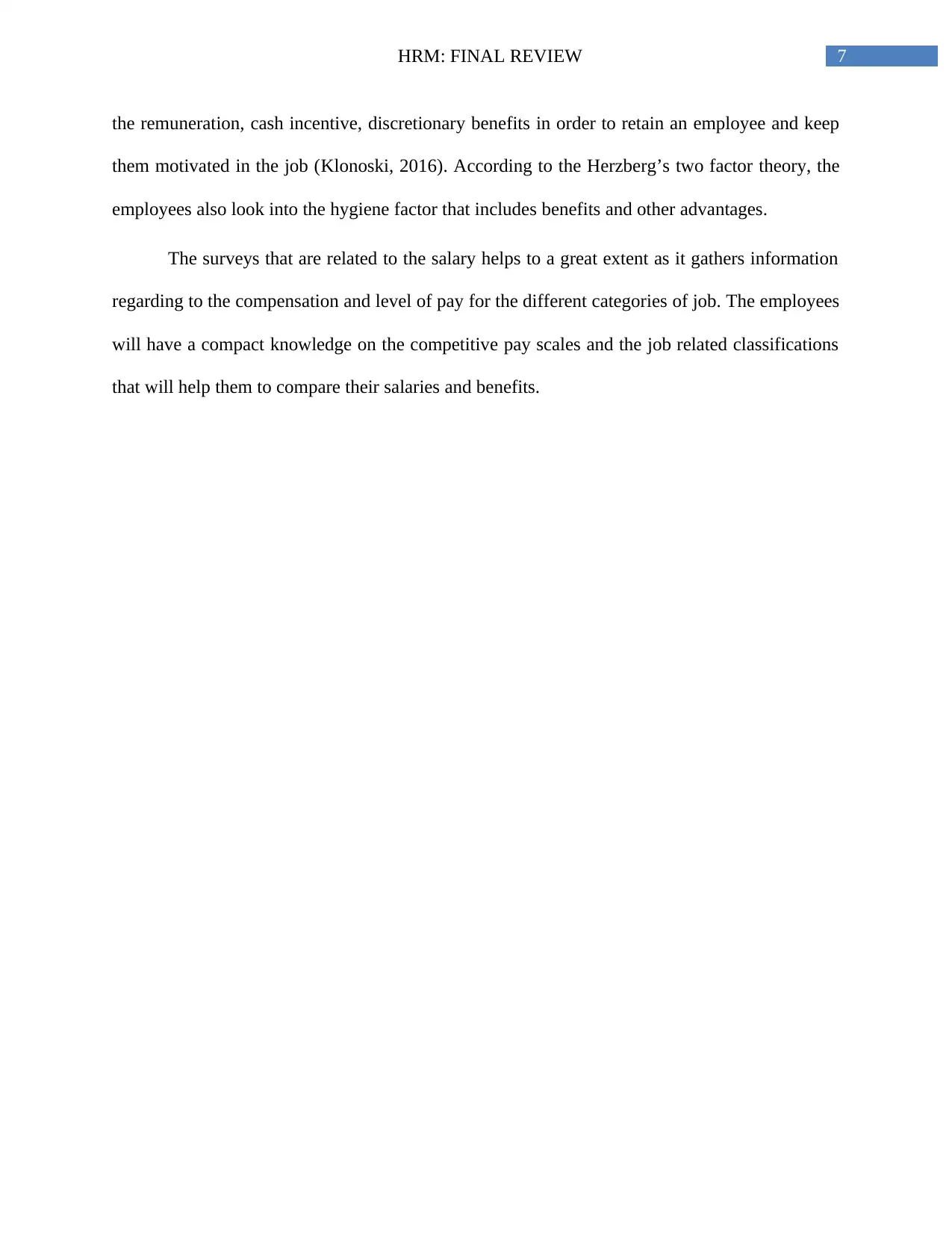
7HRM: FINAL REVIEW
the remuneration, cash incentive, discretionary benefits in order to retain an employee and keep
them motivated in the job (Klonoski, 2016). According to the Herzberg’s two factor theory, the
employees also look into the hygiene factor that includes benefits and other advantages.
The surveys that are related to the salary helps to a great extent as it gathers information
regarding to the compensation and level of pay for the different categories of job. The employees
will have a compact knowledge on the competitive pay scales and the job related classifications
that will help them to compare their salaries and benefits.
the remuneration, cash incentive, discretionary benefits in order to retain an employee and keep
them motivated in the job (Klonoski, 2016). According to the Herzberg’s two factor theory, the
employees also look into the hygiene factor that includes benefits and other advantages.
The surveys that are related to the salary helps to a great extent as it gathers information
regarding to the compensation and level of pay for the different categories of job. The employees
will have a compact knowledge on the competitive pay scales and the job related classifications
that will help them to compare their salaries and benefits.
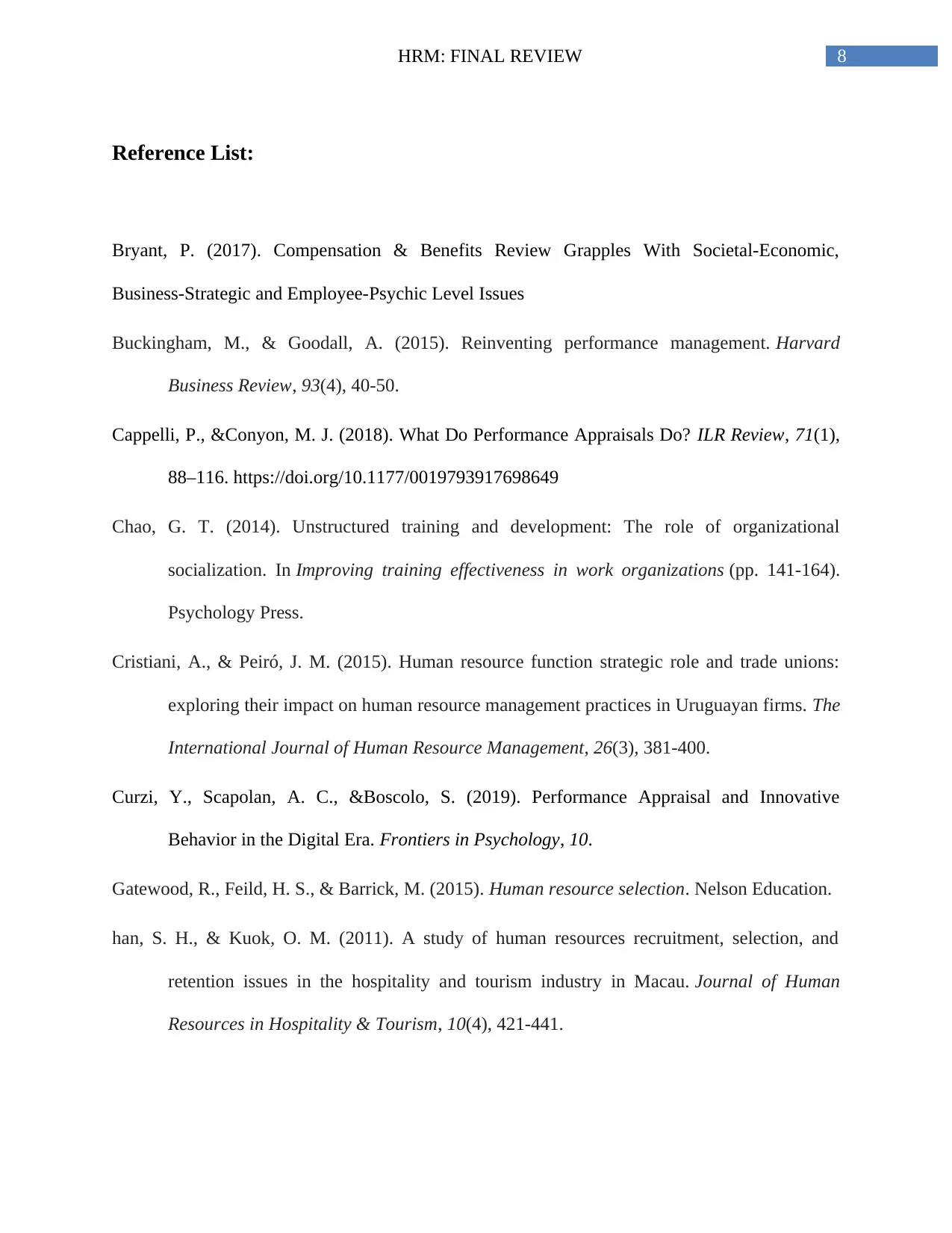
8HRM: FINAL REVIEW
Reference List:
Bryant, P. (2017). Compensation & Benefits Review Grapples With Societal-Economic,
Business-Strategic and Employee-Psychic Level Issues
Buckingham, M., & Goodall, A. (2015). Reinventing performance management. Harvard
Business Review, 93(4), 40-50.
Cappelli, P., &Conyon, M. J. (2018). What Do Performance Appraisals Do? ILR Review, 71(1),
88–116. https://doi.org/10.1177/0019793917698649
Chao, G. T. (2014). Unstructured training and development: The role of organizational
socialization. In Improving training effectiveness in work organizations (pp. 141-164).
Psychology Press.
Cristiani, A., & Peiró, J. M. (2015). Human resource function strategic role and trade unions:
exploring their impact on human resource management practices in Uruguayan firms. The
International Journal of Human Resource Management, 26(3), 381-400.
Curzi, Y., Scapolan, A. C., &Boscolo, S. (2019). Performance Appraisal and Innovative
Behavior in the Digital Era. Frontiers in Psychology, 10.
Gatewood, R., Feild, H. S., & Barrick, M. (2015). Human resource selection. Nelson Education.
han, S. H., & Kuok, O. M. (2011). A study of human resources recruitment, selection, and
retention issues in the hospitality and tourism industry in Macau. Journal of Human
Resources in Hospitality & Tourism, 10(4), 421-441.
Reference List:
Bryant, P. (2017). Compensation & Benefits Review Grapples With Societal-Economic,
Business-Strategic and Employee-Psychic Level Issues
Buckingham, M., & Goodall, A. (2015). Reinventing performance management. Harvard
Business Review, 93(4), 40-50.
Cappelli, P., &Conyon, M. J. (2018). What Do Performance Appraisals Do? ILR Review, 71(1),
88–116. https://doi.org/10.1177/0019793917698649
Chao, G. T. (2014). Unstructured training and development: The role of organizational
socialization. In Improving training effectiveness in work organizations (pp. 141-164).
Psychology Press.
Cristiani, A., & Peiró, J. M. (2015). Human resource function strategic role and trade unions:
exploring their impact on human resource management practices in Uruguayan firms. The
International Journal of Human Resource Management, 26(3), 381-400.
Curzi, Y., Scapolan, A. C., &Boscolo, S. (2019). Performance Appraisal and Innovative
Behavior in the Digital Era. Frontiers in Psychology, 10.
Gatewood, R., Feild, H. S., & Barrick, M. (2015). Human resource selection. Nelson Education.
han, S. H., & Kuok, O. M. (2011). A study of human resources recruitment, selection, and
retention issues in the hospitality and tourism industry in Macau. Journal of Human
Resources in Hospitality & Tourism, 10(4), 421-441.
⊘ This is a preview!⊘
Do you want full access?
Subscribe today to unlock all pages.

Trusted by 1+ million students worldwide
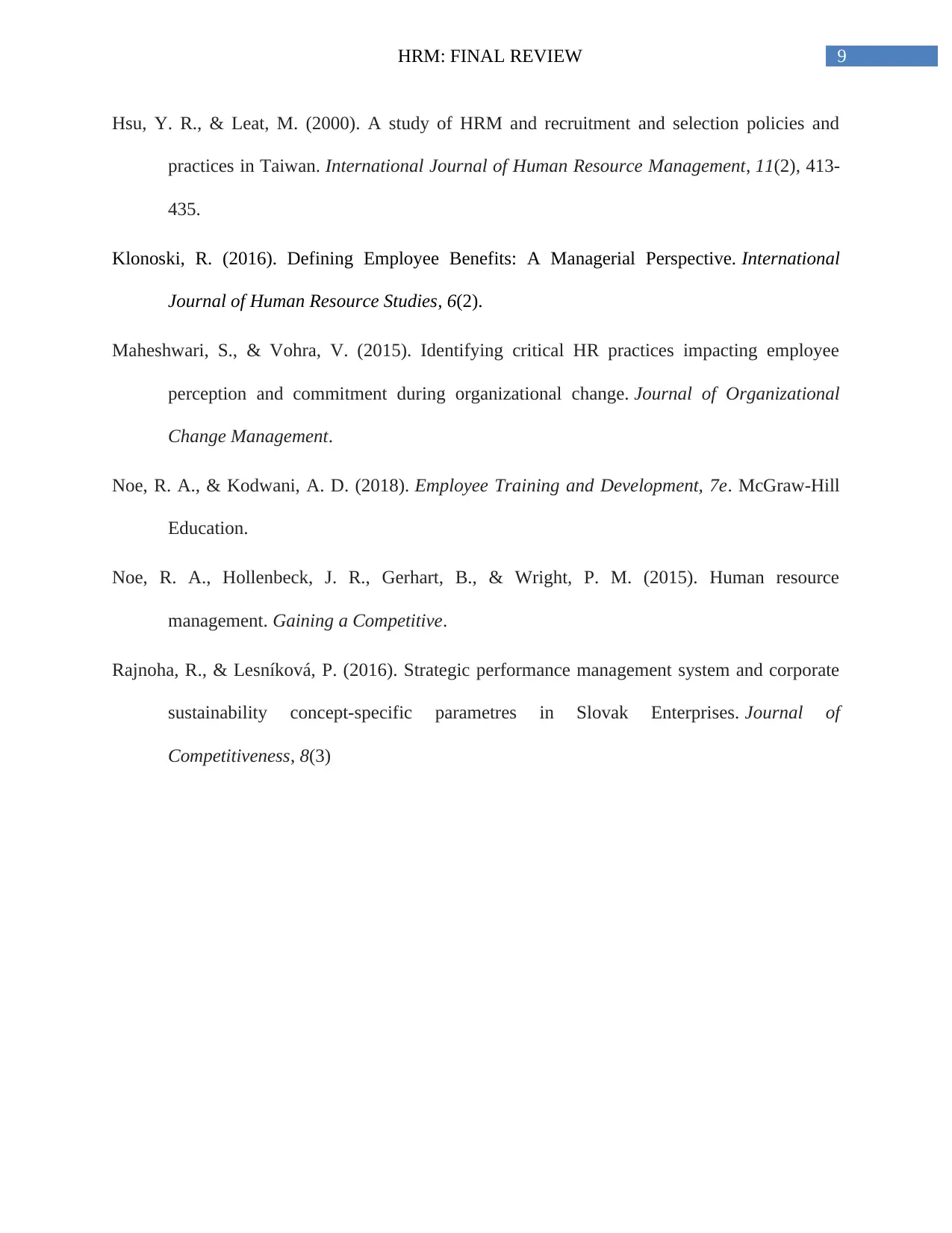
9HRM: FINAL REVIEW
Hsu, Y. R., & Leat, M. (2000). A study of HRM and recruitment and selection policies and
practices in Taiwan. International Journal of Human Resource Management, 11(2), 413-
435.
Klonoski, R. (2016). Defining Employee Benefits: A Managerial Perspective. International
Journal of Human Resource Studies, 6(2).
Maheshwari, S., & Vohra, V. (2015). Identifying critical HR practices impacting employee
perception and commitment during organizational change. Journal of Organizational
Change Management.
Noe, R. A., & Kodwani, A. D. (2018). Employee Training and Development, 7e. McGraw-Hill
Education.
Noe, R. A., Hollenbeck, J. R., Gerhart, B., & Wright, P. M. (2015). Human resource
management. Gaining a Competitive.
Rajnoha, R., & Lesníková, P. (2016). Strategic performance management system and corporate
sustainability concept-specific parametres in Slovak Enterprises. Journal of
Competitiveness, 8(3)
Hsu, Y. R., & Leat, M. (2000). A study of HRM and recruitment and selection policies and
practices in Taiwan. International Journal of Human Resource Management, 11(2), 413-
435.
Klonoski, R. (2016). Defining Employee Benefits: A Managerial Perspective. International
Journal of Human Resource Studies, 6(2).
Maheshwari, S., & Vohra, V. (2015). Identifying critical HR practices impacting employee
perception and commitment during organizational change. Journal of Organizational
Change Management.
Noe, R. A., & Kodwani, A. D. (2018). Employee Training and Development, 7e. McGraw-Hill
Education.
Noe, R. A., Hollenbeck, J. R., Gerhart, B., & Wright, P. M. (2015). Human resource
management. Gaining a Competitive.
Rajnoha, R., & Lesníková, P. (2016). Strategic performance management system and corporate
sustainability concept-specific parametres in Slovak Enterprises. Journal of
Competitiveness, 8(3)
1 out of 10
Related Documents
Your All-in-One AI-Powered Toolkit for Academic Success.
+13062052269
info@desklib.com
Available 24*7 on WhatsApp / Email
![[object Object]](/_next/static/media/star-bottom.7253800d.svg)
Unlock your academic potential
Copyright © 2020–2025 A2Z Services. All Rights Reserved. Developed and managed by ZUCOL.





